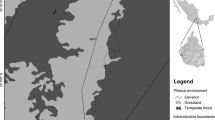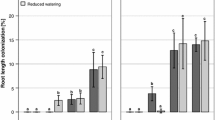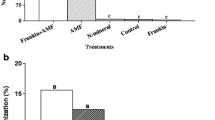Abstract
Vegetative inoculum of Amanita ovoidea (Bull.) Link and three isolates of Suillus collinitus (Fr.) Kuntze, as well as spore inoculum of Rhizopogon roseolus (Corda) Th. M. Fr. and S. collinitus, were evaluated for the production of Pinus halepensis Mill. in nursery and for the establishment of seedlings in a degraded gypsum soil. In nursery, most of the fungi significantly improved the height of seedlings and modified the accumulation of nutrients in needles. The percentage of ectomycorrhizas (ESR) per seedling ranged from 25 to 78%, depending on the fungi. One and 2 years after planting in the field, the survival of seedlings was significantly improved by inoculation with two isolates of S. collinitus and with spores of the same fungus. Inoculation with A. ovoidea had no significant effect on seedling survival, whilst R. roseolus caused a significant mortality of seedlings. Seedling height was significantly improved by inoculation with all fungi except R. roseolus and isolate CCMA-1 of S. collinitus. One year after planting, mycorrhization of control seedlings was negligible, and percentages of ESR were under 38% for the rest of treatments. In spring of the second year, seedlings in all treatments, including the control, became highly mycorrhizal (60-77% of ESR). Low ectomycorrhizal diversity (five morphotypes described) and seasonal variation on morphotype composition were detected 2 years after plantation. From a perspective of soil restoration management under limiting environmental conditions, nursery inoculation with selected fungi can be a key advantage for tree seedlings to surmount the initial transplant stress, assuring their establishment in the field. Our results emphasise the importance of selecting compatible fungal-host species combinations for nursery inoculation and sources of inoculum adapted to the environmental conditions of the transplantation site.




Similar content being viewed by others
References
Agerer R (1987-1998) Colour atlas of ectomycorrhizae. Einhirn-Verlag Eduard Dietenberger, Munich
Agerer R (1995) Anatomical characteristics of identified ectomycorrhizas: an attempt towards a natural classification. In: Varma A, Hock B (eds) Mycorrhiza: structure, function, molecular biology and biotechnology. Springer, Berlin, pp 687-734
Argillier C, Falconnet G, Tillard P, Mousain D (1997) Essais d’introduction dans un arénosol calcaire de Petite-Camargue de pins pignons (Pinus pinea L.) mycorhizés par Suillus collinitus. Rev For Fr 49(2):131-140
Barberá GG, Martinez-Fernandez F, Alvarez-Rogel J, Albaladejo J, Castillo V (2005) Short and intermediate-term effects of site and plant preparation techniques on reforestation of a Mediterranean semiarid ecosystem with Pinus halepensis Mill. New Forest 29:177-198
Brundrett M, Bougher N, Dell B, Grove T, Malajczuk N (1996) Working with mycorrhizas in forestry and agriculture, ACIAR Monograph 32. Camberra, Australia
Brundrett M, Malajczuk N, Mingqin G, Dapin X, Snelling S, Dell B (2005) Nursery inoculation of Eucalyptus seedling in Western Australia and southern China using spore and mycelial inoculum of diverse ectomycorrhizal fungi from different climatic regions. Forest Ecol Manag 209:193-205
Buée M, Vairelles D, Garbaye J (2005) Year-round monitoring of diversity and potential metabolic activity of the ectomycorrhizal community in a beech (Fagus sylvatica) forest subjected to two thinning regimes. Mycorrhiza 15:235-245
Caravaca F, Alguacil MM, Azcón R, Parladé J, Torres P, Roldán A (2005) Establishment of two ectomycorrhizal shrub species in a semiarid site alter in situ amendment with sugar beet, rock phosphate and Aspergillus niger. Microbial Ecol 49:73-82
Castellano MA, Trappe JM, Molina R (1985) Inoculation of container grown Douglas-fir seedlings with basidiospores of Rhizopogon vinicolor and R. colossus: effects of fertility and spore application rate. Can J For Res 15:10-13
Clemente AS, Werner C, Maguas C, Cabral MS, Martins-Louçao MA, Correoa O (2004) Restoration of a limestone quarry: effect of soil amendments on the establishment of native Mediterranean sclerophyllous shrubs. Res Ecol 12:20-28
Cordell CE, Owen JH, Marx DH (1987) Mycorrhizae nursery management for improved seedling quality and field performance. In: Meeting the challenge of the nineties, Proc. Intermount. For. Nursery Assoc. Oklahoma City, Okla, GTR-RM-151, pp 105-115
Dahlberg A, Finlay RD (1999) Suillus. In: Cairney JEGC, Chambers SM (eds) Ectomycorrhizal fungi, key genera in profile. Springer, Berlin, pp 33-64
Dana ED, Mota JF (2006) Vegetation and soil recovery on gypsum outcrops in semi-arid Spain. J Arid Environ 65:444-459
El Karkouri K, Martin F, Mousain D (2004) Diversity of ectomycorrhizal symbionts in a disturbed Pinus halepensis plantation in the Mediterranean region. Ann For Sci 61:705-710
El Karkouri K, Selosse MA, Mousain D (2006) Molecular markers detecting an ectomycorrhizal Suillus collinitus strain on Pinus halepensis roots suggest successful inoculation and persistence in Mediterranean nursery and plantation. FEMS Microbiol Ecol 55:146-158
Fujimura KE, Smith JE, Horton TR, Weber NS, Spatafora TR (2005) Pezizalean mycorrhizas and sporocarps in ponderosa pine (Pinus ponderosa) after prescribed fires in eastern Oregon, USA. Mycorrhiza 15:79-86
García C, Hernández T, Roldán A, Albaladejo J, Castillo V (2000) Organic amendment and mycorrhizal inoculation as a practice in afforestation of soils with Pinus halepensis Miller: effect on their microbial activity. Soil Biol Biochem 32:1173-1181
Gardes M, Bruns TD (1993) ITS primers with enhanced specificity for Basidomycetes: application to identification of mycorrhizae and rusts. Mol Ecol 2:113-118
Gardes M, Bruns TD (1996) Community structure of ectomycorrhial fungi in a Pinus muricata forest: above and below-ground views. Can J Bot 74:1572-1583
González-Ochoa AI, de las Heras H, Torres P, Sánchez-Gómez E (2003) Mycorrhization of Pinus halepensis Mill. and Pinus pinaster Aiton seedlings in two commercial nurseries. Ann For Sci 60:43-48
Grayston SJ, Vaughan D, Jones D (1996) Rhizosphere carbon flow in trees, in comparison with annual plants: the importance of root exudation and its impact on microbial activity and nutrient availability. App Soil Ecol 5:29-56
Grossnickle SC (2005) Importance of root growth in overcoming planting stress. New For 30:273-294
Guerrero-Campo J, Alberto F, Maestro M, Hodgson J, Montserrat-Martí G (1999) Plant community patterns in a gypsum area of NE Spain. II. Effects of ion washing on topographic distribution of vegetation. J Arid Environm 41:411-419
Honrubia M (2000) Mycorrhizas in Pinus halepensis Miller.. In: Neeman G, Trabaud L (eds) Ecology biogeography and management of Pinus halepensis and P. brutia forest ecosystems in the Mediterranean basin. Backhuys, Leiden, pp 191-202
Isaac RA, Kerber JD (1971) Atomic absorption and flame photometry: techniques and uses in soil, plant and water analysis. In: Walsh LM (ed) Instrumental methods for analysis of soils, plant, tissue. Soil Science Society of America, Madison, WI
Le Tacon F, Álvarez IF, Bouchard D, Henrion B, Jackson RM, Luff S, Parladé J, Pera J, Stenström E, Villeneuve N, Walker C (1992) Variations in field response of forest trees to nursery ectomycorrhizal inoculation in Europe. In: Read DJ, Lewis DH, Fitter AH, Alexander IJ (eds) Mycorrhizas in ecosystems. CAB, Oxford, pp 119-134
Maestre FT, Cortina J (2004) Are Pinus halepensis plantations useful as a restoration tool in semiarid Mediterranean areas? For Ecol Manag 198:303-317
Manian S, Sreenivasaprasad S, Bending GD, Mills PR (2001) Genetic diversity and interrelationships among common European Suillus species based on ribosomal DNA sequences. FEMS Microbiol Lett 204:117-121
Marschner H (1986) Mineral nutrition in higher plants. Academic, San Diego, CA
Marx DH (1969) The influence of ectotrophic mycorrhizal fungi on the resistance of pine roots to pathogenic infections. I. Antagonism of mycorrhizal fungi to root pathogenic fungi and soil bacteria. Phytopathol 59:153-163
Marx DH (1991) The pratical significance of ectomycorrhizae in forest establishment. In: Hägglund B (ed) Ecophysiology of ectomycorrhizae of forest trees. Symposium Proceedings no. 7. The Marcus Wallenberg Foundation, Stockholm, Sweden, pp 54-90
Mousain D, Plassard C, Argillier C, Sardin T, Leprince F, El Karkouri K, Arvieu JC, Cleyet-Marel JC (1994) Stratégie d’amélioration de la qualité des plants forestiers et des reboisements méditerranéens par utilisation de la mycorhization contrôlée en pépinière. Acta Bot Gall 141:571-580
Olsson PA, Jakobsen I, Wallander H (2002) Foraging and resource allocation strategies of mycorrhizal fungi in a patchy environment. In: Van der Heijden MGA, Sanders IR (eds) Mycorrhizal ecology. Springer, Berlin, pp 93-115
Palacio S, Escudero A, Montserrat-Martí G, Maestro M, Milla R, Albert MJ (2007) Plants living on gypsum: beyond the specialist model. Ann Bot 99:333-343
Parladé J, Pera J, Álvarez IF (1996) Inoculation of containerised Pseudotsuga menziesii and Pinus pinaster seedlings with spores of five species of ectomycorrhizal fungi. Mycorrhiza 6:237-245
Parladé J, Luque J, Pera J, Rincón A (2004) Field performance of Pinus pinea and P. halepensis seedlings inoculated with Rhizopogon spp. and outplanted in formerly arable land. Ann For Sci 61:507-514
Posta K, Marschner H, Römheld V (1994) Manganese reduction in the rhizosphere of mycorrhizal and non mycorrhizal maize. Mycorrhiza 5:119-124
Querejeta JI, Roldán A, Albadalejo J, Castillo V (1998) The role of mycorrhizae, site preparation, and organic amendment in the afforestation of a semi-arid Mediterranean site with Pinus halepensis. For Sci 44:203-211
Rincón A, Álvarez IF, Pera J (2001) Inoculation of containerized Pinus pinea L. seedlings with seven ectomycorrhizal fungi. Mycorrhiza 11:265-271
Rincón A, Parladé J, Pera J (2005) Effects of ectomycorrhizal inoculation and the type of substrate on mycorrhization, growth and nutrition of containerised Pinus pinea L. seedlings produced in a commercial nursery. Ann For Sci 62:1-6
Rincón A, Ruiz-Diez B, Fernandez-Pascual M, Probanza A, Pozuelo JM, de Felipe MR (2006) Afforestation of degraded soils with Pinus halepensis Mill.: effects of inoculation with selected microorganisms and soil amendment on plant growth, rhizospheric microbial activity and ectomycorrhizal formation. Appl Soil Ecol 34:42-51
Rincón A, Parladé J, Pera J (2007) Influence of the fertilisation method in controlled ectomycorrhizal inoculation of two Mediterranean pines. Ann For Sci 64:577-583
Roldán A, Albaladejo J (1994) Effect of mycorrhizal inoculation and soil restoration on the growth of Pinus halepensis seedlings in a semiarid soil. Biol Fertil Soils 18:143-149
Roldán A, Querejeta JI, Albadalejo J, Castillo V (1996) Growth response of Pinus halepensis to inoculation with Pisolithus arhizus in a terraced rangeland amended with urban refuse. Plant Soil 179:35-43
Román R, Fortun C, Garcia-Lopez de Sa ME, Almendros G (2003) Successful soil remediation and reforestation of a calcic regosol amended with composted urban waste. Arid Land Res Manag 17:311-397
Ruiz-Díez B, Rincón A, de Felipe MR, Fernandez-Pascual M (2006) Molecular characterisation and evaluation of mycorrhizal capacity of Suillus isolates from Central Spain for the selection of fungal inoculants. Mycorrhiza 16:465-474
Selosse MA, Martin F, Bouchard D, Le Tacon F (1999) Structure and dynamics of experimentally introduced and naturally occurring Laccaria sp. discrete genotypes in a Douglas fir plantation. Appl Environ Microbiol 65:2006-2014
Simard SW, Jones MD, Durral DM (2002) Carbon and nutrient fluxes within and between mycorrhizal plants. In: van der Heijden MGA, Sanders I (eds) Mycorrhizal ecology. Springer, Berlin, pp 34-74
Smith SE, Read DJ (1997) Mycorrhizal symbiosis. Academic, Cambridge, UK
Thedesshoo L, Hansen K, Perry BA, Kjoller R (2006) Molecular and morphological diversity of pezizalean ectomycorrhiza. New Phytol 170:581-596
Torres P, Honrubia M (1994) Inoculation of containerized Pinus halepensis seedlings with basidiospores of Pisolithus tinctorius, Rhizopogon roseolus and Suillus collinitus. Ann Sci For 51:521-528
Trappe JM (1977) Selection of fungi for ectomycorrhizal inoculation in nurseries. Annu Rev Phytopathol 15:203-222
White TJ, Bruns T, Lee S, Taylor J (1990) Amplification and direct sequencing of fungal ribosomal RNA genes for phylogenetics. In: Innis MA, Gelfand DH, Sninsky JJ, White TJ (eds) PCR protocols: a guide to methods and applications. Academic, New York, pp 315-322
Acknowledgements
The authors thank Pedro Hernáiz and the group of “La Poveda” (CSIC) for technical assistance. This work was supported by grant GR/AMB/0735/2004 from the Comunidad de Madrid (Spain). A. Rincón holds a I3P postdoctoral fellowship awarded by the Consejo Superior de Investigaciones Científicas (CSIC, Spain).
Author information
Authors and Affiliations
Corresponding author
Rights and permissions
About this article
Cite this article
Rincón, A., de Felipe, M.R. & Fernández-Pascual, M. Inoculation of Pinus halepensis Mill. with selected ectomycorrhizal fungi improves seedling establishment 2 years after planting in a degraded gypsum soil. Mycorrhiza 18, 23–32 (2007). https://doi.org/10.1007/s00572-007-0149-y
Received:
Accepted:
Published:
Issue Date:
DOI: https://doi.org/10.1007/s00572-007-0149-y




